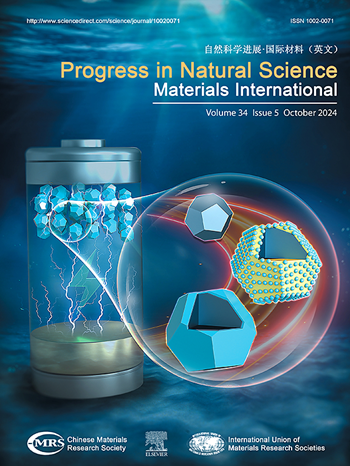Engineering biomass-derived CO2 capture materials via hydrothermal processes
IF 7.1
2区 材料科学
Q2 MATERIALS SCIENCE, MULTIDISCIPLINARY
Progress in Natural Science: Materials International
Pub Date : 2025-04-01
DOI:10.1016/j.pnsc.2025.02.011
引用次数: 0
Abstract
Hydrothermal carbonization (HTC) has emerged as a promising technology for converting biomass into high-performance carbon materials, offering potential sustainable solutions for CO2 capture. HTC operates under moderate conditions to produce hydrochar with enhanced porosity and surface functionality ideally suited for CO2 sequestration. Recently developed nitrogen-doped and alkali metal-activated hydrochars have improved adsorption capacities, and CO2 capture capacities up to 320 mg/g, surpassing some traditional materials like zeolites. However, despite its potential to contribute significantly to global efforts seeking to mitigate carbon emissions, HTC faces challenges such as energy consumption and product variability. In this review we explore the fundamental mechanisms of HTC, emphasizing the transformation of wet biomass into porous, carbon-rich materials suitable for adsorption applications. We also discuss the technoeconomic viability of HTC as a scalable and sustainable technology and highlight future research needs aimed at optimizing reaction conditions, synergizing catalysts and solvents, reducing costs, and improving reactor designs that can help pave HTC's role in a low-carbon future.
工程生物质衍生的二氧化碳捕获材料通过水热过程
水热碳化(HTC)已成为一项将生物质转化为高性能碳材料的有前途的技术,为二氧化碳捕获提供了潜在的可持续解决方案。HTC在中等条件下运行,生产具有增强孔隙度和表面功能的碳氢化合物,非常适合二氧化碳的封存。最近开发的氮掺杂和碱金属活化的水合物具有更好的吸附能力,其CO2捕获能力高达320 mg/g,超过了沸石等传统材料。然而,尽管HTC有潜力为全球减少碳排放的努力做出重大贡献,但它面临着能源消耗和产品可变性等挑战。在这篇综述中,我们探讨了HTC的基本机制,强调将湿生物质转化为适合吸附应用的多孔富碳材料。我们还讨论了HTC作为一种可扩展和可持续技术的技术经济可行性,并强调了未来的研究需求,旨在优化反应条件,协同催化剂和溶剂,降低成本,改进反应器设计,从而帮助HTC在低碳未来中发挥作用。
本文章由计算机程序翻译,如有差异,请以英文原文为准。
求助全文
约1分钟内获得全文
求助全文
来源期刊
CiteScore
8.60
自引率
2.10%
发文量
2812
审稿时长
49 days
期刊介绍:
Progress in Natural Science: Materials International provides scientists and engineers throughout the world with a central vehicle for the exchange and dissemination of basic theoretical studies and applied research of advanced materials. The emphasis is placed on original research, both analytical and experimental, which is of permanent interest to engineers and scientists, covering all aspects of new materials and technologies, such as, energy and environmental materials; advanced structural materials; advanced transportation materials, functional and electronic materials; nano-scale and amorphous materials; health and biological materials; materials modeling and simulation; materials characterization; and so on. The latest research achievements and innovative papers in basic theoretical studies and applied research of material science will be carefully selected and promptly reported. Thus, the aim of this Journal is to serve the global materials science and technology community with the latest research findings.
As a service to readers, an international bibliography of recent publications in advanced materials is published bimonthly.

 求助内容:
求助内容: 应助结果提醒方式:
应助结果提醒方式:


